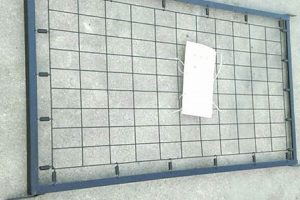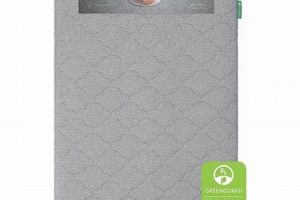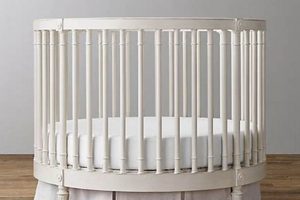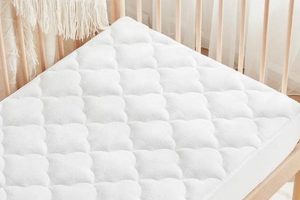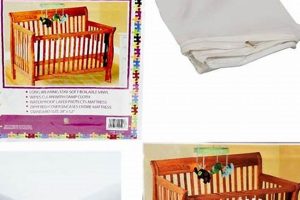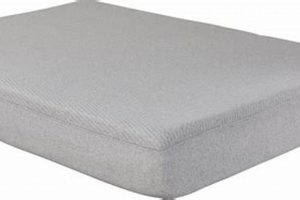A vital component for infant bedding, a waterproof barrier safeguards the crib mattress from spills, accidents, and bodily fluids. These barriers, designed to fit securely over a standard crib mattress, prevent liquids from seeping into the mattress core, thereby inhibiting the growth of bacteria and mold. A common example is a fitted sheet style protector crafted from a breathable, waterproof material like polyurethane.
The incorporation of such a safeguard offers significant advantages. It extends the lifespan of the crib mattress, reducing the frequency of replacement due to damage or unsanitary conditions. Furthermore, it contributes to a healthier sleep environment for the infant by preventing the accumulation of allergens and microorganisms. Historically, less effective methods were employed, highlighting the advancement in textile technology and its application to infant care.
Consequently, a thorough examination of available options, considering factors like material composition, breathability, ease of cleaning, and safety certifications, is essential. Subsequent sections will delve into these critical aspects, providing a comprehensive guide for selecting the most suitable product.
Guidance on Selecting a Suitable Crib Mattress Safeguard
The following provides essential guidance for informed purchasing decisions regarding crib mattress protection. Consider these points to ensure optimal product selection.
Tip 1: Material Composition: Assess the materials used. Options include polyurethane laminates, often lauded for waterproofing, and fabrics with waterproof coatings. Ensure the material is non-toxic and free from harmful chemicals like phthalates and PVC.
Tip 2: Breathability: Select a protector with breathable properties to promote airflow and regulate temperature. Excessive heat can lead to discomfort and increase the risk of overheating.
Tip 3: Waterproofing Effectiveness: Verify the waterproof capability of the product. Look for protectors with a robust waterproof membrane that effectively prevents liquid penetration.
Tip 4: Fit and Secureness: Confirm the protector fits the crib mattress snugly and securely. Loose-fitting protectors can pose a safety hazard. Elasticized edges or fitted sheet styles are often preferred.
Tip 5: Ease of Cleaning: Evaluate the ease of cleaning. Opt for protectors that are machine washable and dryer safe for convenient maintenance.
Tip 6: Safety Certifications: Seek products with relevant safety certifications, such as OEKO-TEX Standard 100, indicating testing for harmful substances.
Tip 7: Durability and Longevity: Consider the product’s durability and anticipated lifespan. A well-constructed protector will withstand repeated washings and maintain its protective qualities over time.
Adhering to these guidelines ensures that the selected crib mattress protection offers a balance of safety, hygiene, and convenience. Prioritizing these features contributes to a healthier and more secure sleep environment for the infant.
The concluding section will synthesize the critical aspects of choosing a crib mattress safeguard, reinforcing its significance in infant care.
1. Material Safety
Material safety stands as a foundational pillar in the selection of a crib mattress safeguard. Given the infant’s prolonged contact with the protector, the composition of the materials directly influences health and well-being. Consequently, rigorous evaluation of material constituents is essential.
- Absence of Harmful Chemicals
The presence of substances like phthalates, lead, and flame retardants in crib mattress protectors can pose significant health risks to infants, including endocrine disruption and developmental issues. Protectors certified to standards like OEKO-TEX Standard 100 ensure that the product has been tested for harmful levels of these chemicals, minimizing exposure and promoting a safer sleep environment.
- Hypoallergenic Properties
Infants with sensitivities or allergies require protectors crafted from hypoallergenic materials. These materials, typically free from common allergens like latex, reduce the likelihood of allergic reactions and skin irritations. Natural fibers, such as organic cotton, are often preferred for their gentleness and breathability, further minimizing the risk of adverse reactions.
- Breathability and Airflow
Material composition impacts breathability, which is crucial for regulating the infant’s body temperature and reducing the risk of overheating. Materials that allow for adequate airflow, like cotton or bamboo, help dissipate heat and moisture, creating a more comfortable and safer sleep surface. Non-breathable materials can trap heat, potentially leading to discomfort or even sudden infant death syndrome (SIDS).
- Durability and Resistance to Degradation
Durable materials, resistant to wear and tear, ensure the protector maintains its integrity over time. Materials that degrade easily may release harmful particles or lose their protective properties. High-quality materials, properly maintained, provide long-term protection and reduce the need for frequent replacements, minimizing potential exposure to new materials.
Ultimately, prioritizing material safety in crib mattress protector selection is paramount. Choosing products with certifications, hypoallergenic properties, breathability, and durability ensures the infant sleeps in a safe and healthy environment, mitigating potential health risks associated with harmful chemicals and allergens.
2. Waterproof Integrity
Waterproof integrity is a defining characteristic of any effective crib mattress protector. It represents the protector’s ability to consistently prevent liquids from penetrating the mattress core. Compromised waterproof integrity leads to moisture accumulation, creating a breeding ground for bacteria and mold, which in turn poses health risks to the infant. For instance, a protector with weakened seams or a damaged waterproof membrane will allow urine or spilled formula to seep into the mattress, negating its intended purpose.
The importance of this attribute stems from the frequency and nature of infant-related spills and accidents. Crib mattresses are subjected to bodily fluids, regurgitation, and diaper leaks. Without adequate waterproof protection, the mattress becomes a reservoir for contaminants, potentially causing allergic reactions or respiratory problems. A high-quality, impermeable barrier prevents these scenarios, safeguarding the mattress and promoting a sanitary sleep environment. The best options are those that maintain their integrity even after repeated washing and use, indicating a durable and reliable construction.
In conclusion, waterproof integrity is not merely a feature but a fundamental requirement for effective crib mattress protection. It is the primary defense against contamination and the cornerstone of a healthy sleeping space. Evaluating a protector’s waterproof capabilities, through testing or certifications, is crucial in selecting a product that genuinely contributes to the infant’s well-being.
3. Breathability
Breathability, in the context of crib mattress protection, refers to the material’s capacity to permit air and moisture vapor to pass through it. While complete waterproof integrity is essential, a lack of breathability can create a microclimate of elevated humidity and temperature directly beneath the infant. This can lead to discomfort, increased sweating, and potentially exacerbate skin conditions like eczema. A non-breathable safeguard traps heat, disrupting the infant’s thermal regulation, and may contribute to restlessness or even an increased risk of overheating. Consider the scenario where a crib mattress protector effectively blocks liquids but also restricts airflow; the infant’s body heat becomes trapped, leading to increased sweating and potential discomfort, negating the benefits of a clean mattress.
Effective breathability mitigates these risks. By allowing air circulation, it helps regulate the infant’s body temperature, creating a more comfortable and stable sleep environment. Materials like cotton blends or those incorporating specialized membranes facilitate the transfer of moisture vapor away from the skin, reducing humidity and the likelihood of skin irritation. The practical application of this understanding lies in selecting protectors specifically designed to balance waterproof protection with breathable properties. These often utilize advanced textile technologies to achieve both objectives, such as incorporating microporous membranes that block liquids while allowing air to permeate. The effectiveness of breathability can be often felt when touching the protector. Protector should have ability to provide cooler touch for infant.
In summary, breathability is a crucial, often overlooked, component of an optimal crib mattress safeguard. It’s a factor balancing water resistance and thermal comfort. Neglecting breathability can lead to discomfort and potential health concerns, outweighing the benefits of basic waterproof protection. Therefore, choosing a protector that prioritizes both impermeability and airflow is paramount for ensuring a safe and comfortable sleep environment for the infant.
4. Secure Fit
The attribute of “secure fit” holds paramount importance in the context of a crib mattress safeguard. A properly fitting protector not only enhances the product’s functionality but also directly influences the infant’s safety and sleep quality. An ill-fitting protector negates many of the benefits otherwise provided.
- Prevention of Bunching and Slipping
A secure fit ensures that the protector remains taut and smooth across the crib mattress surface. Loose or oversized protectors are prone to bunching and slipping, creating uneven surfaces that can disrupt the infant’s sleep and potentially pose a suffocation hazard. A fitted sheet style with elasticized edges helps maintain a snug and secure fit, minimizing these risks.
- Maintenance of Waterproof Coverage
An adequately fitted protector provides consistent waterproof coverage across the entire mattress surface. Gaps or exposed areas compromise the protector’s ability to prevent liquids from reaching the mattress core, undermining its primary function. A protector that conforms precisely to the mattress dimensions ensures complete and reliable protection against spills and accidents.
- Minimization of Entrapment Risk
Excess material from a poorly fitted protector can create loose folds or gaps between the protector and the mattress. Infants can become entangled in this loose material, leading to potential entrapment hazards. A snug, secure fit eliminates these risks by removing excess fabric and ensuring a smooth, conforming surface.
- Preservation of Mattress Integrity
A well-fitted protector contributes to the long-term integrity of the crib mattress. By preventing moisture from seeping into the mattress core, it inhibits the growth of bacteria and mold, extending the mattress’s lifespan and maintaining a hygienic sleep environment. A loose-fitting protector fails to provide this comprehensive protection, potentially leading to mattress degradation and the need for premature replacement.
In summary, the “secure fit” of a crib mattress safeguard is not merely a matter of convenience but a critical element impacting safety, hygiene, and product effectiveness. A properly fitted protector minimizes risks, maximizes protection, and contributes to a healthier sleep environment for the infant. Selecting a protector with precise dimensions and a secure fitting mechanism is therefore essential.
5. Cleanability
Cleanability is an indispensable characteristic of a superior crib mattress safeguard. The inherent function of such a protector involves exposure to bodily fluids, spills, and other contaminants, necessitating frequent and effective cleaning. A protector lacking ease of cleaning diminishes its practical value and compromises the hygiene of the sleep environment. For example, a protector requiring specialized cleaning agents or methods may discourage regular maintenance, leading to the accumulation of allergens and microorganisms, thereby negating the intended benefit.
The correlation between effortless cleaning and hygiene is direct. Protectors designed for machine washing and drying offer convenience and efficiency, promoting consistent upkeep. Conversely, materials or constructions that trap moisture or require laborious cleaning processes can foster bacterial growth, rendering the protector a potential health hazard. The ability to quickly and thoroughly clean the protector after each incident minimizes exposure to irritants and ensures a sanitary sleep surface. Consider a scenario involving a diaper leak; a wipeable or machine-washable protector allows for immediate and effective remediation, preventing mattress contamination and maintaining hygiene standards.
In summary, cleanability is intrinsically linked to the performance and value of a crib mattress safeguard. Prioritizing protectors with straightforward cleaning protocols enhances hygiene, extends the product’s lifespan, and contributes to a healthier sleep environment for the infant. The selection process should, therefore, emphasize materials and designs that facilitate effortless and effective cleaning procedures, ensuring that the protector consistently fulfills its intended purpose.
Frequently Asked Questions
The following addresses common inquiries regarding crib mattress protection. These responses aim to clarify key aspects and inform decision-making.
Question 1: What constitutes a “best” waterproof crib mattress protector?
A superior protector effectively prevents liquid penetration, is constructed from safe, non-toxic materials, permits adequate airflow, fits the mattress securely, and withstands repeated cleaning cycles without degradation. Certifications from recognized safety organizations are also indicative of a quality product.
Question 2: Why is waterproof protection necessary for a crib mattress?
Infant mattresses are susceptible to spills, accidents, and bodily fluids. Waterproof protection prevents these substances from seeping into the mattress core, mitigating the growth of bacteria, mold, and allergens, thereby promoting a healthier sleep environment and extending mattress lifespan.
Question 3: How does breathability impact the effectiveness of a waterproof crib mattress protector?
While waterproof protection is crucial, breathability is equally important. Breathable materials allow air to circulate, regulating the infant’s body temperature and reducing the risk of overheating. An impermeable protector lacking breathability can trap heat and moisture, leading to discomfort and potential skin irritation.
Question 4: What materials are considered safe for a waterproof crib mattress protector?
Safe materials are non-toxic, free from harmful chemicals such as phthalates, lead, and PVC, and ideally certified by organizations like OEKO-TEX. Hypoallergenic materials are also preferable, particularly for infants with sensitivities or allergies.
Question 5: How often should a waterproof crib mattress protector be cleaned?
The protector should be cleaned immediately after any spill or accident. Regular cleaning, at least monthly, is also recommended to maintain hygiene and prevent the accumulation of allergens and microorganisms. Refer to the manufacturer’s instructions for specific cleaning guidelines.
Question 6: Can a waterproof crib mattress protector replace a mattress pad?
A waterproof crib mattress protector primarily serves to protect the mattress from liquids and contaminants. While some protectors may offer a degree of padding, a separate mattress pad can enhance comfort and support. The choice depends on individual preferences and the specific features of the protector.
Selecting an appropriate crib mattress safeguard involves careful consideration of material safety, waterproof integrity, breathability, secure fit, and cleanability. Prioritizing these factors ensures optimal hygiene and protection for the infant’s sleep environment.
The subsequent section will delve into reviews and comparisons of commercially available products, further assisting in informed decision-making.
Best Waterproof Crib Mattress Protector
The preceding discussion has underscored the multifaceted nature of selecting a “best waterproof crib mattress protector.” Material safety, waterproof integrity, breathability, secure fit, and cleanability emerge as non-negotiable attributes. These characteristics collectively contribute to a safe, hygienic, and comfortable sleep environment, mitigating risks associated with allergens, bacteria, and potential hazards.
Therefore, the acquisition of a suitable crib mattress safeguard warrants diligent research and careful evaluation. A product meeting the stringent criteria outlined herein represents not merely a purchase but a crucial investment in the infant’s health and well-being. Prioritizing informed decision-making in this area contributes significantly to fostering a secure and sanitary foundation for early development.


